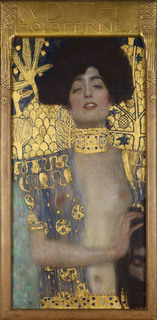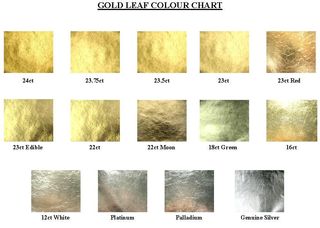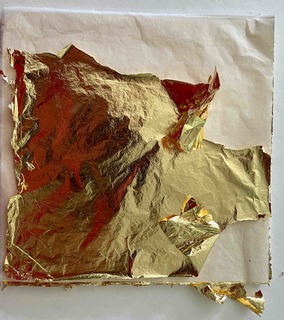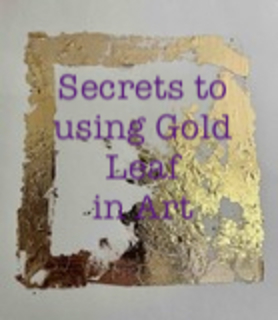My Secrets to Using Gold Leaf in Art
Gold or silver leaf isn’t just for gilding things like mirrors, you can use it in your paintings too, just check out Gustav Klimt’s work where he used small amounts to highlight areas or as in this one titled Judith and the Head of Holofernes he used quite a bit.
I often use gold or silver leaf in my abstract artworks. It also comes in handy for such thing as jewellery or special effects in surrealist paintings and my infamous Boozehag range as well.
You will be surprised that its actually much easier to use than you think. You can try using some of the gold or silver paints instead but they don’t have quite the same effect, the reason being that gold paints are not really gold ... and will tarnish over time.
Some of the newer paints supposedly will not tarnish, but even so, the resemblance to real gold is remote, at best and despite the ease of applying this material, its visual and physical properties are inferior to those of gold leaf.
You can try buying a tube of top artist's quality gold paint and a small gilding starter set, to see what each is like working with and then see how you feel about the results you get. Be willing to experiment and to create studies, rather than focusing on producing final paintings.

Different Types of Leaf
You should note that there are also real gold leaf and imitation gold leaf. Real gold leaf can even be used on food as its edible but imitation is not, do not get them confused.
You also need to make sure you varnish imitation gold leaf as it will tarnish and go a dull dark brown pretty quickly. The genuine leaf will be richer in colour and finish and if its importnt to your work you can use the fact its genuine as a selling point.
There are also different coloured metal leaves available such as blue and green shimmer effects. You can get Genuine Gold Leaf which is Pure 24 carat, the Red Gold is 23 carat and the Yellow Gold is 21 carat gold. Als available is variegated Leaf - This comes in Blue, Red, Green and Black.
As real gold leaf is made of actual gold it is pricey, so you need to weigh up if its worth it for art projects. You can purchase it from art stores but imitation gold leaf is available at other places like craft stores as well.

So how do we use the leaf?
1) Preparation is important. The leaf is very fine, like I'm talking super fine, its light as a feather and very delicate, so any surface imperfections or texture underneath will show through the leaf exactly how it is on the surface.
Gold leaf is a top surface medium mening that it should be one of the last things you apply before varnishing, so make sure you have done all the background and painting you need to do before placing it where you want it to be. If you are happy with the surface finish, then its time to apply the size. Here are some samples of what size is available
2) Size is either a water or oil based adhesive used to attach the metal leaf to a surface so it's similar to glue. A water based size dries quickly and has a usable tack life, usually 24 hours. You can buy this from art supply stores. Alternatively you can use an acrylic medium and some people use a thinned down PVA glue but its not recommended. Especially in humid climates as the glue can reactivate and what you used it to apply can slide off the surface.
3) A traditional oil based size works best on hard smooth surfaces but will take longer to dry sufficiently to accept the leaf.
Apply the size only on the area you want to see the leaf as leaf will stick to every tiny bit of adhesive it comes across.
Use smooth even strokes and avoid creating puddles or runs, (the leaf is wafer thin so any marks underneath will be visible when finished). As the size dries it will become clear with a tacky consistency. To test if the size is ready to accept the leaf lightly press your knuckle to the surface, if it makes a clicking sound when you pull it away it is ready. Do not test using your finger tip as it will leave a print that will show through the leaf, or worse it will remove the size from that area. The size I use recommends at least 15 minutes before applying the leaf.
Size will remain tacky for some time, though if leaving overnight make sure the surface is covered and dust free. Just mak sure you do the application before 24 hours is up or you will have to reapply the adhesive again.
4) Applying the leaf is the tricky bit; Most leaf usually comes loose or is available as a transfer, (attached to tissue paper), making it easier to apply. If you tend to get sticky hands then wear cotton gloves when handling to avoid tarnishing when working with with the leaf, or try using talcum powder on your hands to make sure they are really dry.
TIP - make sure your room is not draughty, you need the air to be really still when working with this product as it will simply fly away and can be much more difficult to place.

Once the size is tacky, place the gold leaf on the object and brush it gently with a very soft brush. Lay the next sheet of leaf down so that it overlaps slightly, and repeat until the surface is covered. When applying to raised surfaces you may need to use small pieces of leaf to fill crevices first, and use a soft bristle brush to tamp down the leaf into the grooves. To get a shiny metal finish, use a burnisher (this is a pen like tool with a smooth agate stone as a point.
I personally use a soft to medium brush as it creates a softer effect for what I require. Although if you're not careful you can dull the finish down so test this method out beofre using on artwork as you dont want to be disappointed.At this stage leave it to dry and harden and then brush off any excess leaf particles.
Now you need to varnish to protect or if you like it, use shellac for a rich warm gloss finish. Shellac has a lovely golden glow to it, that helps with an antiqued finish if that’s the effect you are after. Shellac comes in White, Ruby,
I use gold leaf a lot and its one thing I like to teach my students to use when I do my night school classes. Heres a couple pieces where i have incorporated it into my paintings

The Ghost Dress Series can be purchased from the DRESS GALLERY
The History of Gold Leaf
Gold leaf's rich history dates back to ancient civilisations. The process of creating gold leaf involves hammering gold into thin sheets, which can then be applied to various surfaces for decorative purposes. Here is a brief overview of the history of gold leaf:
Ancient Egypt-
The use of gold leaf dates back to ancient Egypt, where gold was considered a symbol of the gods and used extensively in art and architecture. The Egyptians used gold leaf to decorate the burial chambers of pharaohs and other important figures. They also used it to gild statues and objects of religious significance.
Ancient Rome-
The Romans inherited the use of gold leaf from the Egyptians and used it in a variety of ways. They used it to decorate buildings, furniture, and household objects. The famous Colosseum in Rome was once covered in gold leaf, which has since been lost to time.
Medieval Europe-
During the Middle Ages, gold leaf was used extensively in religious art, such as illuminated manuscripts and church altarpieces. It was also used to decorate royal palaces and castles.
Renaissance-
The Renaissance saw a resurgence of interest in the classical world and the use of gold leaf in art. Artists such as Michelangelo and Leonardo da Vinci used gold leaf to highlight important elements of their works, such as halos and robes.
Modern times: Today, gold leaf is still used in a variety of ways, from fine art to interior design. It can be found in everything from religious iconography to luxury automobiles. The process of creating gold leaf has remained largely unchanged for centuries, with craftsmen hammering gold into thin sheets by hand.
Posted: Monday 22 February 2010




